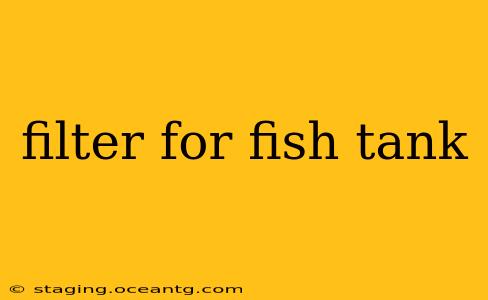Keeping a thriving aquarium requires diligent maintenance, and a crucial component of that is a high-quality filter. Choosing the right filter can seem daunting with so many options available, but understanding the different types and their functionalities will help you make an informed decision. This guide will walk you through the key considerations, answering common questions to ensure your fish remain healthy and happy.
What are the Different Types of Aquarium Filters?
Aquarium filters are broadly categorized into several types, each with its own strengths and weaknesses. Choosing the best type depends on your tank size, the number of fish, and your budget.
-
Undergravel Filters (UGF): These filters use a plate of porous material placed under the gravel bed. Water is drawn through the gravel, picking up waste, and then passed through a biological filter medium. While they provide good biological filtration, they can be difficult to clean and are less efficient than other filter types.
-
Hang-on-Back (HOB) Filters: These are the most common type of filter for smaller to medium-sized tanks. They hang on the back of the tank, are relatively inexpensive, and easy to maintain. They usually combine mechanical, biological, and chemical filtration.
-
Canister Filters: These are powerful external filters ideal for larger tanks. They sit on the floor and are connected to the tank via tubing. Canister filters offer excellent filtration capabilities across all three types (mechanical, biological, and chemical) and are highly effective at keeping the water clean. They require more initial investment and more involved cleaning.
-
Internal Filters: These compact filters sit inside the tank, usually submerged. They're suitable for smaller tanks, are relatively inexpensive, and easy to install. However, they can take up some tank space and may not be as powerful as other filter types.
-
Sponge Filters: These are simple, air-driven filters that are excellent for breeding tanks and smaller setups. They provide primarily biological filtration and are very quiet and easy to maintain.
What Size Filter Do I Need for My Fish Tank?
The filter's capacity should be matched to the tank's volume. A general guideline is to choose a filter with a flow rate that can process the entire tank's water volume several times per hour. For example, a 20-gallon tank would ideally benefit from a filter with a flow rate capable of circulating the entire 20 gallons at least four times per hour (80 gallons per hour). Always check the manufacturer's specifications for the recommended tank size. Overfiltering is less of a problem than underfiltering.
How Often Should I Change My Filter Media?
This depends on the type of filter media and the filter itself. Mechanical filter media, such as filter sponges, may need replacing every few weeks or months, depending on how dirty they become. Biological filter media, like ceramic rings or bio-balls, generally don't need replacing unless physically damaged. Chemical filter media, such as activated carbon, should be replaced regularly according to the manufacturer's instructions, typically every few weeks to a month.
What is the Best Filter for a Beginner?
For beginners, Hang-on-back (HOB) filters are generally recommended due to their ease of use, affordability, and effectiveness. They are easy to install and maintain, making them a perfect choice for those new to the hobby.
How Do I Clean My Aquarium Filter?
Cleaning your aquarium filter properly is essential for maintaining water quality. Never use tap water; always use dechlorinated water from your aquarium. Rinse the mechanical filter media (sponges and filter pads) gently in old tank water to remove debris. Avoid using soap or harsh chemicals, as these can harm beneficial bacteria. For biological media, only rinse it if absolutely necessary, and then gently, to avoid killing off the essential bacteria colonies.
What are the Benefits of Different Types of Aquarium Filter Media?
Different filter media serve various purposes:
- Mechanical Media: (sponges, filter floss) traps larger debris.
- Biological Media: (ceramic rings, bio-balls, lava rock) houses beneficial bacteria that break down ammonia and nitrite.
- Chemical Media: (activated carbon) removes impurities like chlorine and discoloration.
By carefully considering your tank size, budget, and maintenance preferences, you can select the ideal filter to maintain a healthy and thriving aquarium environment for your fish. Remember, regular maintenance is crucial for optimal filter performance.
